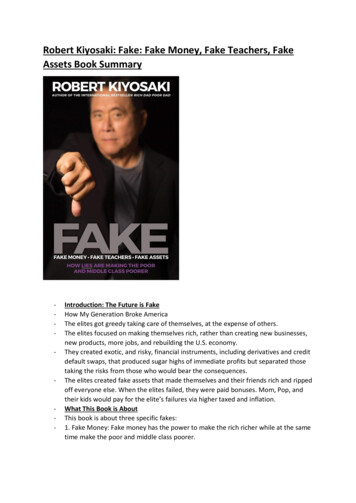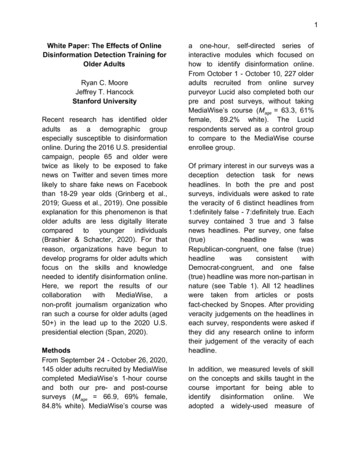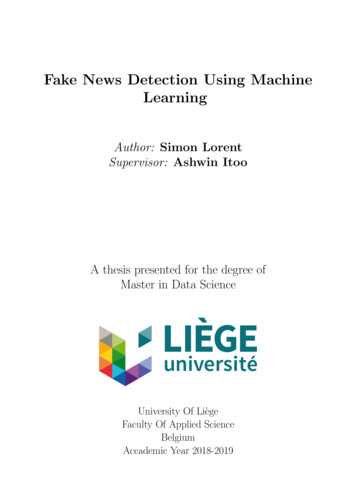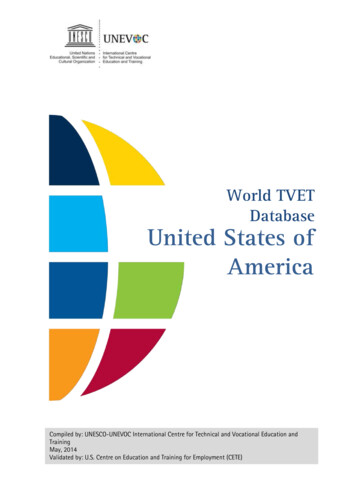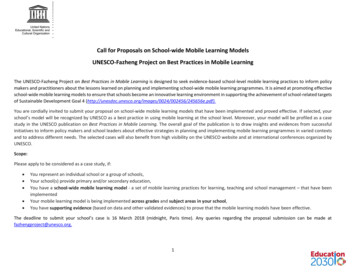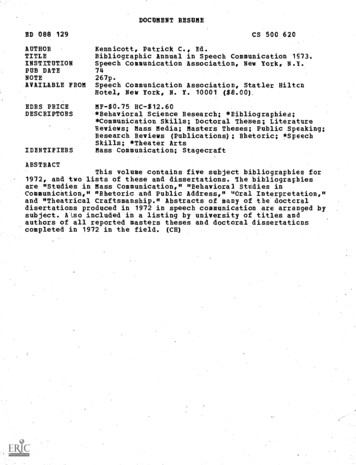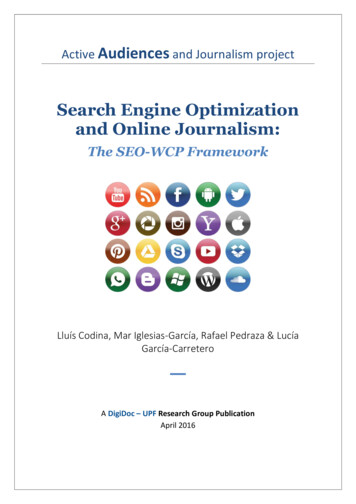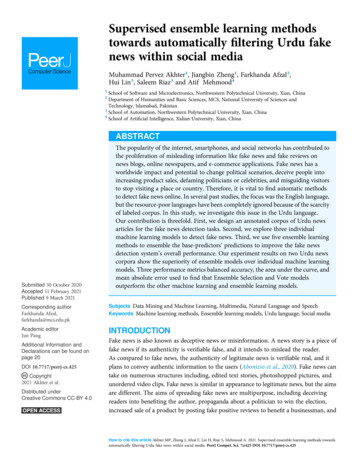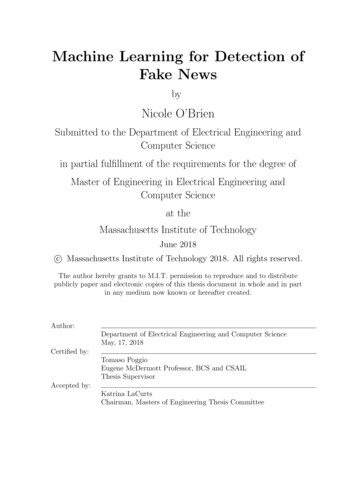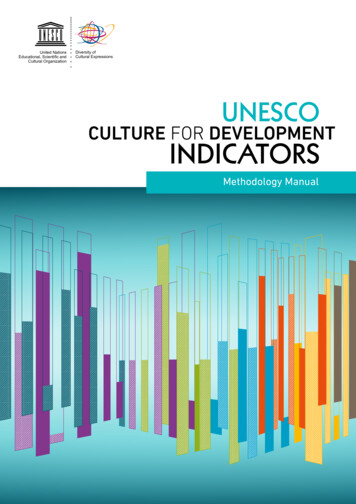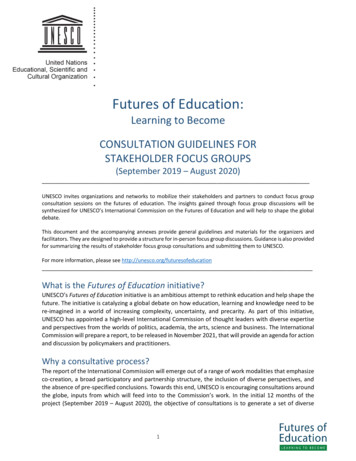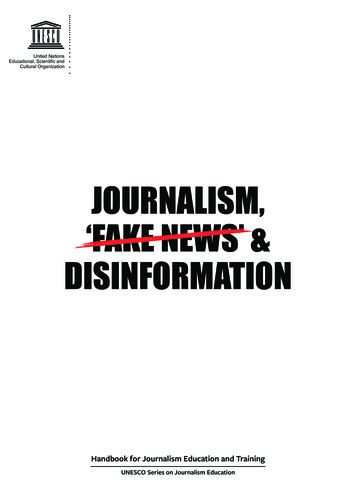
Transcription
United NationsEducational, Scientific andCultural OrganizationJOURNALISM,‘FAKE NEWS’ &DISINFORMATIONHandbook for Journalism Education and TrainingUNESCO Series on Journalism Education
Published in 2018 by the United Nations Educational, Scientific and Cultural Organization,7, place de Fontenoy, 75352 Paris 07 SP, France UNESCO 2018ISBN: 978-92-3-100281-6This publication is available in Open Access under the Attribution-ShareAlike 3.0 IGO (CC-BY-SA 3.0 IGO) 3.0/igo/). By using the content of this publication, the users accept to be boundby the terms of use of the UNESCO Open Access Repository a-en).The designations employed and the presentation of material throughout this publication do not imply theexpression of any opinion whatsoever on the part of UNESCO concerning the legal status of any country,territory, city or area or of its authorities, or concerning the delimitation of its frontiers or boundaries.The ideas and opinions expressed in this publication are those of the authors; they are not necessarily those ofUNESCO and do not commit the Organization.Editors: Cherilyn Ireton and Julie PosettiContributing Authors: Julie Posetti, Cherilyn Ireton, Claire Wardle, Hossein Derakhshan, Alice Matthews, Magda Abu-Fadil, TomTrewinnard, Fergus Bell, Alexios MantzarlisAdditional Research: Tom LawGraphic design: Mr. ClintonCover design: Mr. ClintonIllustrations: UNESCO, First Draft and PoynterTypeset: UNESCOPrinted by: UNESCOPrinted in France
Cherilyn Iretonand Julie PosettiJournalism,‘Fake News’ &DisinformationHandbook for Journalism Education and Training
TABLE OF CONTENTSForeword by Guy Berger7Introduction by Cherilyn Ireton and Julie Posetti14Using this handbook as a model curriculum by Julie Posetti26MODULE 1: Truth, trust and journalism: why it matters32by Cherilyn IretonSynopsisOutlineModule AimsLearning OutcomesModule FormatSuggested AssignmentReadingMODULE 2: Thinking about ‘information disorder’:formats of misinformation, disinformation, and mal-informationby Claire Wardle and Hossein DerakhshanSynopsisOutlineModule AimsLearning OutcomesModule FormatSuggested 51535353MODULE 3: News industry transformation: digital technology, socialplatforms and the spread of misinformation and disinformation55by Julie PosettiSynopsisOutlineModule AimsLearning OutcomesModule FormatSuggested AssignmentReading55576565666768
MODULE 4: Combatting disinformation and misinformationthrough Media and Information Literacy (MIL)by Magda Abu-FadilSynopsisOutlineModule AimsLearning OutcomesModule FormatSuggested AssignmentMaterialsReadingMODULE 5: Fact-checking 101by Alexios MantzarlisSynopsisOutlineModule aimsLearning outcomesModule FormatSuggested 3MODULE 6: Social media verification:assessing sources and visual content96by Tom Trewinnard and Fergus BellOutlineModule AimsLearning OutcomesModule FormatSuggested LE 7: Combatting online abuse:when journalists and their sources are targeted109by Julie PosettiSynopsisOutlineModule AimsLearning OutcomesModule FormatSuggested 121
FOREWORDUNESCO works to strengthen journalism education, and this publication is the latestoffering in a line of cutting-edge knowledge resources.It is part of the “Global Initiative for Excellence in Journalism Education”, which is afocus of UNESCO’s International Programme for the Development of Communication(IPDC). The Initiative seeks to engage with teaching, practising and researching ofjournalism from a global perspective, including sharing international good practices.Accordingly, the current handbook seeks to serve as an internationally-relevant modelcurriculum, open to adoption or adaptation, which responds to the emerging globalproblem of disinformation that confronts societies in general, and journalism inparticular.It avoids assuming that the term ‘fake news’ has a straightforward or commonlyunderstood meaning.1 This is because ‘news’ means verifiable information in the publicinterest, and information that does not meet these standards does not deserve the labelof news. In this sense then, ‘fake news’ is an oxymoron which lends itself to underminingthe credibility of information which does indeed meet the threshold of verifiability andpublic interest – i.e. real news.To better understand the cases involving exploitative manipulation of the language andconventions of news genres, this publication treats these acts of fraud for what theyare – as a particular category of phony information within increasingly diverse forms ofdisinformation, including in entertainment formats like visual memes.In this publication, disinformation is generally used to refer to deliberate (oftenorchestrated) attempts to confuse or manipulate people through deliveringdishonest information to them. This is often combined with parallel and intersectingcommunications strategies and a suite of other tactics like hacking or compromising ofpersons. Misinformation is generally used to refer to misleading information created ordisseminated without manipulative or malicious intent. Both are problems for society,but disinformation is particularly dangerous because it is frequently organised, wellresourced, and reinforced by automated technology.1See Tandoc E; Wei Lim, Z and Ling, R. (2018). “Defining ‘Fake News’: A typology of scholarly definitions” in Digital Journalism (Taylor andFrancis) Volume 6, 2018 - Issue 2: ‘Trust, Credibility, Fake News’.This content is from: Journalism, ‘Fake News’& Disinformation. UNESCO. 2018-7-Download full book:https://bit.ly/2MuELY5
The purveyors of disinformation prey on the vulnerability or partisan potential ofrecipients whom they hope to enlist as amplifiers and multipliers. In this way, they seekto animate us into becoming conduits of their messages by exploiting our propensitiesto share information for a variety of reasons. A particular danger is that ‘fake news’ inthis sense is usually free – meaning that people who cannot afford to pay for qualityjournalism, or who lack access to independent public service news media, are especiallyvulnerable to both disinformation and misinformation.The spread of disinformation and misinformation is made possible largely through socialnetworks and social messaging, which begs the question of the extent of regulation andself-regulation of companies providing these services. In their character as intermediaryplatforms, rather than content creators, these businesses have to date generally beensubject to only light-touch regulation (except in the area of copyright). In the contextof growing pressures on them, however, as well as the risks to free expression posedby over-regulation, there are increased – although patchy – steps in the frame of selfregulation.2 In 2018, the UN Special Rapporteur on Freedom of Expression and Opinionfocused his annual report on the issue, urging the Internet companies to learn fromself-regulation in the news media, and to better align with UN standards on the rightto impart, seek and receive information.3 Within this fast evolving ecology of measurestaken by both states and companies, there is a very significant role for journalists andnews media, which is where this publication comes in.Discerning differencesDisinformation and misinformation are both different to (quality) journalism whichcomplies with professional standards and ethics. At the same time they are alsodifferent to cases of weak journalism that falls short of its own promise. Problematicjournalism includes, for example, ongoing (and uncorrected) errors that arise from poorresearch or sloppy verification. It includes sensationalising that exaggerates for effect,and hyper-partisan selection of facts at the expense of fairness.But this not to assume an ideal of journalism that somehow transcends all embeddednarratives and points of view, with sub-standard journalism being coloured by ideology.Rather it is to signal all journalism contains narratives, and that the problem with2Manjoo, F. (2018). What Stays on Facebook and What Goes? The Social Network Cannot Answer. New York Times, 19 July, 2018. book-misinformation.html [accessed on 20/07/2018]; able-news/ [accessed on 15/07/2018]; https://youtube.googleblog.com/ [accessed on 15/07/2018]; atsapp-seeks-help-fake-news/ [accessed on 15/07/2018].3Report of the Special Rapporteur on the promotion and protection of the right to freedom of opinion and expression. UN Human RightsCouncil 6 April 2018. A/HRC/38/35. 096/72/PDF/G1809672.pdf?OpenElement[accessed on 20/07/2018].This content is from: Journalism, ‘Fake News’& Disinformation. UNESCO. 2018-8-Download full book:https://bit.ly/2MuELY5
sub-standard journalism is not the existence of narratives, but poor professionalism. This iswhy weak journalism is still not the same as disinformation or misformation.Nevertheless, poor quality journalism sometimes allows disinformation andmisinformation to originate in or leak into the real news system. But the causesand remedies for weak journalism are different to the case of disinformation andmisinformation. At the same time, it is evident that strong ethical journalism is neededas an alternative, and antidote, to the contamination of the information environmentand the spill-over effect of tarnishing of news more broadly.Today, journalists are not just bystanders watching an evolving avalanche of disinformationand misinformation. They find themselves in its pathway too4. This means that:ɒ journalism faces the risk of being drowned out by the cacophony;ɒ journalists risk being manipulated by actors who go beyond the ethicsof public relations by attempting to mislead or corrupt journalists intospreading disinformation5;ɒ journalists as communicators who work in the service of truth, including“inconvenient truths”, can find themselves becoming a target of lies, rumoursand hoaxes designed to intimidate and discredit them and their journalism,especially when their work threatens to expose those who are commissioningor committing disinformation6.In addition, journalists need to recognise that while the major arena of disinformationis social media, powerful actors today are instrumentalising ‘fake news’ concerns toclamp down on the genuine news media. New and stringent laws are scapegoatingnews institutions as if they were the originators, or lumping them into broad newregulations which restrict all communications platforms and activities indiscriminately.Such regulations also often have insufficient alignment to the international principlesrequiring that limitations on expression should be demonstrably necessary, proportionaland for legitimate purpose. Their effect, even if not always the intention, is to makegenuine news media subject to a “ministry of truth” with the power to suppressinformation for purely political reasons.In today’s context of disinformation and misinformation, the ultimate jeopardy isnot unjustifiable regulation of journalism, but that publics may come to disbelieve4Despite the threat, according to one study the newsrooms in one country lacked systems, budget and trained personnel dedicated tocombating disinformation. See: Penplusbytes. 2018. Media Perspectives on Fake News in Ghana. d 12/06/2018].5Butler, P. 2018. How journalists can avoid being manipulated by trolls seeking to spread disinformation. tion. See also Module Three of this handbook.6See Module SevenThis content is from: Journalism, ‘Fake News’& Disinformation. UNESCO. 2018-9-Download full book:https://bit.ly/2MuELY5
all content – including journalism. In this scenario, people are then likely to take ascredible whatever content is endorsed by their social networks, and which correspondswith their hearts – but leaves out engagement with their heads. We can already seethe negative impacts of this on public beliefs about health, science, interculturalunderstanding and the status of authentic expertise.This impact on the public is also especially concerning for elections, and to the very ideaof democracy as a human right. What disinformation seeks, particularly during a poll, isnot necessarily to convince the public to believe that its content is true, but to impacton agenda setting (on what people think is important) and to muddy the informationalwaters in order to weaken rationality factors in people’s voting choices7. Likewise, theissues of migration, climate change and others can be highly impacted by uncertaintyresulting from disinformation and misinformation.These dangers are why confronting the rise of ‘fake news’ head-on is an imperative forjournalism and journalism education. At the same time, the threats also constitute anopportunity to double down on demonstrating the value of news media. They providea chance to underline in professional practice the distinctiveness of delivering verifiableinformation and informed comment in the public interest8.What journalism needs to doIn this context, it is a time for news media to tack more closely to professionalstandards and ethics, to eschew the publishing of unchecked information, and to takea distance from information which may interest some of the public but which is not inthe public interest.This publication is therefore also a timely reminder that all news institutions, andjournalists whatever their political leanings, should avoid inadvertently and uncriticallyspreading disinformation and misinformation. In much news media today, theelimination of positions providing internal fact checking has to an extent led to thefunction now being assumed by the “fifth estate” of bloggers and other external actorswho call out mistakes made by journalists – though after they are already disseminated.This emergent phenomenon can be welcomed by news media as reinforcing society’sinterest in verifiable information. Journalists should bring the work of independentfact-checking groups to larger audiences. But they should know that where external7Lipson, D (2018) Indonesia’s ‘buzzers’ paid to spread propaganda as political elite wage war ahead of election, ABC News: ion/9928870?pfmredir sm [accessed 17/8/18].8See also: Nordic Council of Ministers. 2018. Fighting Fakes - the Nordic Way. Copenhagen: Nordic Council of Ministers. fakes-nordic-way [accessed 12/06/2018].This content is from: Journalism, ‘Fake News’& Disinformation. UNESCO. 2018- 10 -Download full book:https://bit.ly/2MuELY5
actors demonstrate systemic failure in a given news outlet, this puts a question markover at least that institution’s brand as a professional source of news. The media shouldbe careful that external post-publication corrections do not become a substitute forinternal processes of quality control. Journalists have to do better and “get it right” inthe first place, or forfeit the possibility of a society to have believable media.In sum, a game of catch-up corrections by external watchdogs is not one in whichjournalism is a winner. Journalists cannot leave it to fact-checking organisations to dothe journalistic work of verifying questionable claims that are presented by sources(no matter whether such claims are reported in the media, or whether they bypassjournalism and appear directly in social media). The ability of news practitioners to gobeyond “he said, she said” journalism, and to investigate the veracity of claims made bythose being covered has to be improved.Journalism also needs to proactively detect and uncover new cases and forms ofdisinformation. This is mission critical for the news media, and it represents analternative to regulatory approaches to ‘fake news’. As an immediate response to aburning and damaging issue, it complements and strengthens more medium-termstrategies such as media and information literacy which empower audiences todistinguish what is news, disinformation and misinformation. Disinformation is a hotstory, and strong coverage of it will strengthen journalism’s service to society.This handbook therefore is a call to action. It is also an encouragement for journaliststo engage in societal dialogue about how people at large decide on credibility and whysome of them share unverified information. As with the news media, for journalismschools and their students, along with media trainers and their learners, this is amajor opportunity for strong civic engagement with audiences. As an example,‘crowd-sourcing’ is essential if media are to uncover and report on beneath-the-radardisinformation that is spread on social messaging or email.UNESCO’s rolesFunded by UNESCO’s International Programme for the Development of Communication(IPDC), this new resource provides a unique and holistic view of the different dynamics ofthe disinformation story, along with practical skills-building to complement the knowledgeand understanding presented.9 It is part of UNESCO’s record of encouraging optimumperformance and self-regulation by journalists, as an alternative to the risks of having stateintervention to deal with perceived problems in the freedom of expression realm.9The 61st meeting of the IPDC Bureau in 2017 decided to support the Global Initiative for Excellence in Journalism Education by making aspecial allocation to develop new syllabi on new key topics for journalism. Progress was reported to the 62nd meeting of the IPDC Bureauin 2018, which then allocated an additional amount to support this curriculum.This content is from: Journalism, ‘Fake News’& Disinformation. UNESCO. 2018- 11 -Download full book:https://bit.ly/2MuELY5
The publication comes on the heels of two earlier UNESCO works “Teaching Journalismfor Sustainable Development: New Syllabi”10 (2015), and “Model Curriculum forJournalism Education: A Compendium of New Syllabi” (2013). These publications inturn are sequels to UNESCO’s seminal “Model Curriculum on Journalism Education11”published in 2007 in nine languages.Other publications of ongoing value and within UNESCO’s publications relevant tojournalism education and training include:ɒ Model course on the safety of journalists (2017)12ɒ Terrorism and the Media: a handbook for journalists (2017)13ɒ Climate Change in Africa: A Guidebook for Journalists (2013)14ɒ Global Casebook of Investigative Journalism (2012) 15ɒ Story-Based Inquiry: A Manual for Investigative Journalists (2009)16ɒ Conflict-sensitive reporting: state of the art; a course for journalists andjournalism educators (2009)17Each of these publications has proved valuable in scores of countries around the world,where journalism educators and trainers, as well as students and working journalists,have improved their practice in various ways. In some places, they have had the flexibilityto adapt entire multi-year programmes in line with the new knowledge and inspiration;in others, it has been a matter of integrating elements from the UNESCO resources intoexisting courses. The quality and coherence of this new publication can be expected togenerate the same value for readers.Since UNESCO is an intergovernmental organisation, it does not take sides in thegeopolitics of information contestation. As is well known, there are varying claims andcounter-claims about disinformation. Such knowledge should inform the reading of thistext, as well as inspire readers to help gather further evidence about various cases.10 sm-for-sustainable-development/ [accessed el-curricula-for-journalism-education/ [accessed leases-model-course-safety-journalists [accessed -and-media-handbook-journalists [accessed 12/06/2018].14 -africa-a-guidebook-for-journalists/ [accessed on -global-investigative-journalism-casebook/ [accessed 12/06/2018].16 8e.pdf [accessed e-for-journalists-and-journalism-educators/ [accessed on 12/06/2018].This content is from: Journalism, ‘Fake News’& Disinformation. UNESCO. 2018- 12 -Download full book:https://bit.ly/2MuELY5
Meanwhile, avoiding relativism, the handbook firmly embeds within its pages the followingcompetencies as constituting unassailable foundations for assessment and action:1. Knowledge that news – produced by transparent actors and which isverifiable - is essential for democracy, development, science, health andhuman progress,2. Recognition that disinformation is not a side-show, and that combatting it ismission critical to news media,3. Commitment to enhanced professional journalistic skills as essential ifinclusive and accurate journalism is to compete as a credible alternative tocounterfeit content.Other powerful and vital literacies covered in this publication, which are especiallyrelevant to journalists and news media outlets, include:1. Knowledge and skills to set up newsroom systems to ensure that there issystematic monitoring, investigating and reporting on disinformation,2. Knowledge about the value of partnerships between media institutions,journalism schools, NGOs, fact-checkers, communities, Internet companiesand regulators, in combatting information pollution,3. Knowledge about the need to engage the public on why it is important tocherish and defend journalism from being overwhelmed by disinformationor being targeted by malicious actors directing disinformation campaignsagainst journalists.Overall, this publication should help societies become more informed about the rangeof societal responses to disinformation problems, including those by governments,international organisations, human rights defenders, Internet companies, andproponents of media and information literacy. It particularly highlights what can be doneby journalists themselves and by the people who educate and train them.We hope that, in its modest way, this handbook can help to reinforce the essentialcontribution that journalism can make to society – and also to the SustainableDevelopment Goals’ ambition of “public access to information and fundamentalfreedoms”. UNESCO thanks the editors and the contributors for making this publicationa reality. It is therefore commended to you, the reader, and we welcome your feedback.Guy BergerDirector for Freedom of Expression and Media Development, UNESCOSecretary of the IPDCThis content is from: Journalism, ‘Fake News’& Disinformation. UNESCO. 2018- 13 -Download full book:https://bit.ly/2MuELY5
INTRODUCTIONCherilyn Ireton and Julie Posetti1To serve as a model curriculum, this handbook is designed to give journalism educatorsand trainers, along with students of journalism, a framework and lessons to helpnavigate the issues associated with ‘fake news’. We also hope that it will be a usefulguide for practising journalists.It draws together the input of leading international journalism educators, researchersand thinkers who are helping to update journalism method and practice to deal with thechallenges of misinformation and disinformation. The lessons are contextual, theoreticaland in the case of online verification, extremely practical. Used together as a course, orindependently, they can help refresh existing teaching modules or create new offerings.A suggestion of How to use this handbook as a model curriculum follows this introduction.There was debate over the use of the words ‘fake news’ in the title and lessons.‘Fake news’ is today so much more than a label for false and misleading information,disguised and disseminated as news. It has become an emotional, weaponised termused to undermine and discredit journalism. For this reason, the terms misinformation,disinformation and ‘information disorder’, as suggested by Wardle and Derakhshan2, arepreferred, but not prescribed3 4.Joint Declaration on Freedom of Expression and ‘Fake News’, Disinformationand PropagandaThis handbook has been produced in a context of growing international concern abouta ‘disinformation war’ in which journalism and journalists are prime targets. In early2017, as this project was being commissioned by UNESCO, a relevant joint statementwas issued by the UN Special Rapporteur for Freedom of Opinion and Expression,the OSCE’s Representative on Freedom of the Media, the Organisation of AmericanStates’ Special Rapporteur on Freedom of Expression, and the African Commission onHuman and People’s Rights Special Rapporteur on Freedom of Expression and Access1Alice Matthews of ABC Australia and Tom Law of the Ethical Journalism Network contributed research, ideas and resources which arereflected in this introduction.2Module Two3The argument against using the term ‘fake news’ has been made by many writers and journalists themselves, including Basson, A. (2016)If it’s fake, it’s not news. ts-stop-talking-about-fake-news-20170706 [accessed12/06/2018].4Wardle, C et al. (2018). “Information Disorder: the essential glossary”. Shorenstein Center, Harvard University. Available 018/07/infoDisorder glossary.pdf?x25702 [accessed 21/07/2018].This content is from: Journalism, ‘Fake News’& Disinformation. UNESCO. 2018- 14 -Download full book:https://bit.ly/2MuELY5
to Information. The Declaration expressed alarm at the spread of disinformationand propaganda, and attacks on news media as ‘fake news’. The Rapporteurs andRepresentatives specifically acknowledged the impacts on journalists and journalism:“(We are) Alarmed at instances in which public authorities denigrate, intimidateand threaten the media, including by stating that the media is “the opposition” oris “lying” and has a hidden political agenda, which increases the risk of threats andviolence against journalists, undermines public trust and confidence in journalismas a public watchdog, and may mislead the public by blurring the lines betweendisinformation and media products containing independently verifiable facts.” 5Disinformation is an old story, fuelled by new technologyMobilising and manipulating information was a feature of history long before modernjournalism established standards which define news as a genre based on particular rulesof integrity. An early record dates back to ancient Rome6, when Antony met Cleopatraand his political enemy Octavian launched a smear campaign against him with “short,sharp slogans written upon coins in the style of archaic Tweets.”7 The perpetratorbecame the first Roman Emperor and “fake news had allowed Octavian to hack therepublican system once and for all”.8But the 21st century has seen the weaponisation of information on an unprecedentedscale. Powerful new technology makes the manipulation and fabrication of contentsimple, and social networks dramatically amplify falsehoods peddled by States, populistpoliticians, and dishonest corporate entities, as they are shared by uncritical publics.The platforms have become fertile ground for computational propaganda9, ‘trolling’10and ‘troll armies’11; ‘sock-puppet’ networks’12, and ‘spoofers’13. Then, there is the arrival ofprofiteering ‘troll farms’ around elections.145UN/OSCE/OAS/ACHPR (2017). Joint Declaration on Freedom of Expression and “Fake News”, Disinformation, Propaganda: https://www.osce.org/fom/302796?download true [accessed 29/03/2017]. See also: Kaye, D (2017) Statement to the UN General Assembly on October24th, 2017: ews.aspx?NewsID 22300&LangID E [accessed: 20/8/18].6See a timeline plotting selected manifestations of ‘information disorder’ - from Cleopatra’s era to the present - in a guide published by theInternational Center for Journalists (ICFJ) Posetti, J & Matthews, A (2018): -news-anddisinformation-new-icfj-learning-module [accessed 23/07/2018].7Kaminska, I. (2017). A lesson in fake news from the info-wars of ancient Rome. Financial Times. f253db7791c6 [accessed 28/03/2018].8ibid9See: Oxford Internet Institute’s Computational Propaganda Project: http://comprop.oii.ox.ac.uk/ [accessed 20/07/2018].10 See Module Seven of this handbook for case studies demonstrating these threats11Rappler.com (2018) Fake News in the Philippines: Dissecting the Propaganda Machine ine [accessed 20/07/2018].12Gent, E. (2017). Sock puppet accounts unmasked by the way they write and post. post/ [
Download full book: https://bit.ly/2MuELY5 sub-standard journalism is not the existence of narratives, but poor professionalism. This is why weak journalism is still not the same as disinformation or misformation. Nevertheless, po
